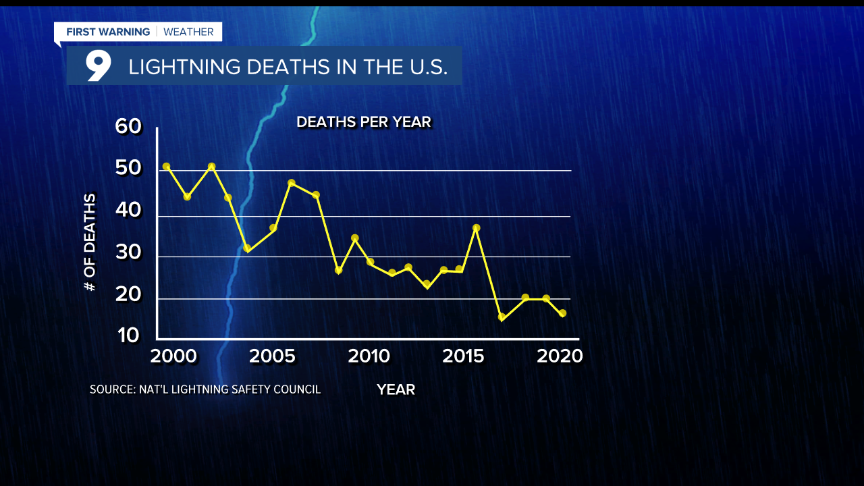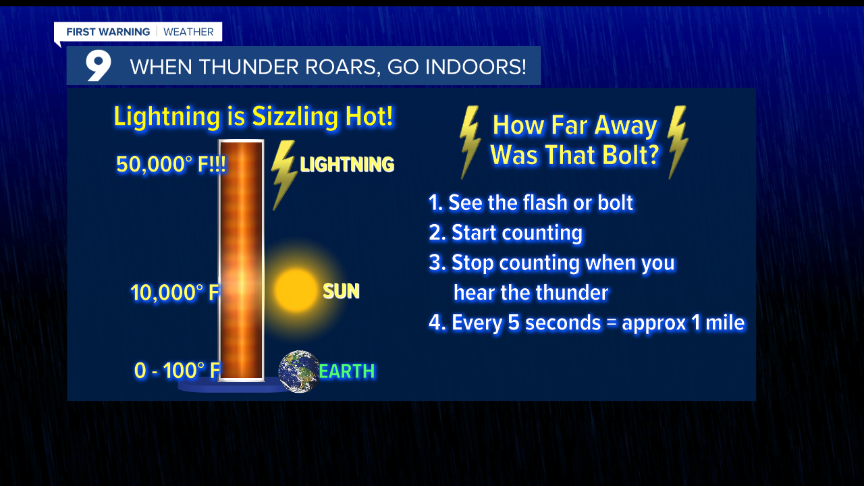TUCSON, Ariz. (KGUN) — Plenty of moisture will provide plenty of fuel for thunderstorms as we finish the month of June and head into the Fourth of July weekend. As we plan our outdoor activities for the holiday weekend, this would be a good time for a little refresher on some facts and safety tips regarding lightning.

According to the National Weather Service, Arizona consistently ranks in the top ten states for the greatest number of lightning deaths per year. Florida almost always leads the nation in being the state with the most lightning strikes per year with an average of over 1.3 million strikes per year according to lightning data provider Vaisala. Arizona only sees about half the lightning strikes as Florida (about 540,000 strikes per year) but we still rank high for lightning strike deaths.
One of the reasons for this is because we live in a place where we spend a lot of time outdoors. Arizona provides a wonderful environment for outdoor recreation and, with that, comes a greater risk of being struck by lightning. One of the most common activities people were doing while killed by lightning was fishing. Other activities included being at the beach and camping.

One death is too many, but we are noticing a downward trend in lightning deaths in the United States. Over the last 20 years, we’ve noticed a substantial decline even though we still average close to 20 deaths by lightning strikes per year.

This is great news considering our population has increased and more people are spending time outside. One of the reasons for the decline in lightning deaths is because the message is finally getting out about the dangers of lightning. The First Warning Weather team has always done our part to bring awareness to lightning safety and we’ll continue to do so!

Lightning is nothing to take lightly. The average lightning bolt is five times hotter than the sun! Yes, the sun averages about 10,000°F and the average lightning bolt has a sizzling temperature of about 50,000°F! The extreme heat of a lightning bolt is what causes thunder.
The extreme heat of a lightning bolt causes the air around the bolt to rapidly expand. This rapid rise in temperature creates a rapid increase in air pressure. The air essentially explodes outward from the bolt and compresses the surrounding air. As the heated air expands, the pressure drops while the air cools and contracts. The result is a shock wave similar to that of a sonic boom when an airplane breaks the sound barrier. The closer we are to the bolt, the louder the boom and we can even hear a snap and a sizzling noise if we’re really close, too close!
To estimate how far away a lightning bolt struck, there’s a simple formula. From the time you see the flash of lightning, start counting. Count until you hear the thunder. Every 5 seconds of counting equals about 1 mile in distance. If you see the bolt and count less than 5 seconds, you are in extreme danger and should seek shelter immediately!

If you do find yourself outside, there are some things you can do to reduce your risk of being struck by lightning. Be sure to avoid tall objects. Lightning won’t always strike the tallest object, but odds are lightning bolts do favor taller objects.
Make yourself as small as possible. You don’t want to be an easy target for a lightning bolt. If you are able, assume a crouch position on the balls of your feet and remain in that position until the storm passes. Most storms will pass in a matter of minutes, but keep in mind that lightning can strike up to 10 miles from the main thunderstorm.
The best way to avoid getting caught in a lightning storm is to be aware of conditions that may produce lightning. The First Warning Weather team will keep you informed with forecasts that will let you know if lightning is possible or not. If lightning is in the forecast, you would be wise to adjust your outdoor plans to be able to take shelter if thunderstorms approach your area.
Becoming familiar with the weather and patterns that may produce thunderstorms will also help you avoid dangerous situations regarding lightning. Cumulus clouds, the one’s with puffy tops, will grow into towering cumulus which are capable of producing lightning bolts. You won’t necessarily see rain before lightning strikes. Many times, lightning will strike before rain starts to fall and lightning is usually more prevalent on the leading edge of a thunderstorm.
Like so many other things in life, situational awareness is key. Knowing when lightning is likely will help you prevent a tragedy. Having safety options when you find yourself outside when lightning is in the area is key. Always have a place of safety to go to in the event lightning approaches your area.
Most importantly, let’s all enjoy the beauty of monsoon and the sound of the thunder it brings. Let’s just make sure to do it from a safe distance and place!



